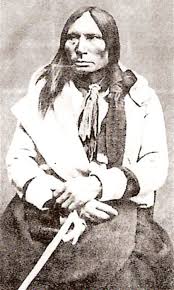 Yes, time travel is possible. How? Read a book. The old-fashioned kind of book, made from paper, isn’t technically a machine, so no Time Machine is required. However, for purists we have computers, tablets, cell-phones, dedicated reading devices and a whole host of other machines that can transport you back in time via the printed page (or screen if you prefer).
Yes, time travel is possible. How? Read a book. The old-fashioned kind of book, made from paper, isn’t technically a machine, so no Time Machine is required. However, for purists we have computers, tablets, cell-phones, dedicated reading devices and a whole host of other machines that can transport you back in time via the printed page (or screen if you prefer).
Now some may protest that reading about the past is not traveling there. I won’t argue. For me, reading about the past or stories set in the past is a transportive experince. Lately, I’ve been transported to Wyoming territory in the year 1875. Much was going on at that time. The Lakota nation was fighting for its rights to its holy lands and hunting grounds. Gold had been discovered in the Black Hills–smack in the middle of those holy lands. Settlers were pushing westward at the urging of the Union Pacific railroad. The railroad needed passengers, and it held rights to land along the path of the railway. Land that the railway owners hoped to sell to settlers at a huge profit. If all of that wasn’t enough fights were brewing not just among the Lakota and the settlers but between cattlemen, sheep owners, and farmers. Stagecoach and railway robberies were common place and towns sprang up to provide services to the far flung ranches, farms and mines
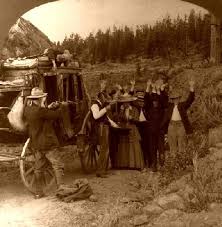 Use that marvelous time machine, the internet, and drill down a layer or three on any one of these topics and you find time travel gold. Be present at the skirmishes that led to the Battle of Little Big Horn and later to the tragedy at Wounded Knee. Get shaken to the bone on a runaway stagecoach as it flees road agents who to steal everything on board, including your own personal treasures. Follow Ferdinand V. Hayden (surveyor), William Henry Jackson (Photographer), and Thomas Moran (artist) and their party as they survey what is now Yellowstone National Park. They “compiled a comprehensive report, including large-format photographs
Use that marvelous time machine, the internet, and drill down a layer or three on any one of these topics and you find time travel gold. Be present at the skirmishes that led to the Battle of Little Big Horn and later to the tragedy at Wounded Knee. Get shaken to the bone on a runaway stagecoach as it flees road agents who to steal everything on board, including your own personal treasures. Follow Ferdinand V. Hayden (surveyor), William Henry Jackson (Photographer), and Thomas Moran (artist) and their party as they survey what is now Yellowstone National Park. They “compiled a comprehensive report, including large-format photographs 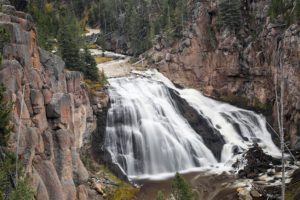 by William Henry Jackson and paintings by Thomas Moran. The report helped to convince the U.S. Congress to withdraw this region from public auction,” and by 1872 Presitent U. S. Grant signed The Act of Dedication law that created Yellowstone National Park. Jackson’s photographs were of particular interest to me even though I’d visited the park in person twice.
by William Henry Jackson and paintings by Thomas Moran. The report helped to convince the U.S. Congress to withdraw this region from public auction,” and by 1872 Presitent U. S. Grant signed The Act of Dedication law that created Yellowstone National Park. Jackson’s photographs were of particular interest to me even though I’d visited the park in person twice.
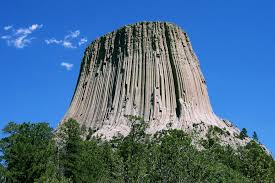 My most recent time travels took me to the trail from Laramie to Devil’s Tower.I caught a ride with a muleskiner who was making deliveries from the rail head at Laramie to out lying ranches. This particular skinner had a good relationship with the Lakota, repsected their lands and would trade with them honestly. No cheating, no shoddy goods, no spoiled stores. The skinner had earned the trust of the Lakota bands that lived in the area of Devil’s Tower. That was a feat few settlers could manage, simply because prejudice and ignorance took precendence over common sense and courtesy.
My most recent time travels took me to the trail from Laramie to Devil’s Tower.I caught a ride with a muleskiner who was making deliveries from the rail head at Laramie to out lying ranches. This particular skinner had a good relationship with the Lakota, repsected their lands and would trade with them honestly. No cheating, no shoddy goods, no spoiled stores. The skinner had earned the trust of the Lakota bands that lived in the area of Devil’s Tower. That was a feat few settlers could manage, simply because prejudice and ignorance took precendence over common sense and courtesy.
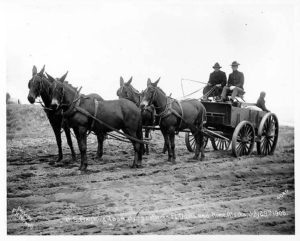 Sadly my mule skinner didn’t spend long with any one group, so I didn’t learn much about the Lakota other than that they were folks with the same kinds of worries, hopes and dreams that most folks have. I did learn quite a bit about the low-lifes taking advantage of not just the Lakota but every person who gave trust too easily. That’s how I discovered that my mule skinner–a major character in my current work in progress–falls victim to the machinations of a villain who is actually trying to increase tensions between the Lakota and the settlers. That villain figures that he can get land at very cheap prices if the area is deemed unsafe. Then he can have the army clear the Lakota off their lands and lay claim to those too.
Sadly my mule skinner didn’t spend long with any one group, so I didn’t learn much about the Lakota other than that they were folks with the same kinds of worries, hopes and dreams that most folks have. I did learn quite a bit about the low-lifes taking advantage of not just the Lakota but every person who gave trust too easily. That’s how I discovered that my mule skinner–a major character in my current work in progress–falls victim to the machinations of a villain who is actually trying to increase tensions between the Lakota and the settlers. That villain figures that he can get land at very cheap prices if the area is deemed unsafe. Then he can have the army clear the Lakota off their lands and lay claim to those too.
All of this, we normally call research, is what I call time travel. The great thing is that anyone can do it. So the next time you go online or pick up a book ask yourself not what you want to know, but instead, when you want to be. Please leave a comment and share some of your time travel experiences.

Recent Comments